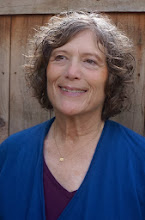As I queried in our May newletter, breathes there anybody with soul so dead as not to love baby blue eyes. Low-growing, good for the front of the flower border, and stunning in large containers, baby blue eyes is a universal favorite.
Seed can be sown this time of the year in the midwest and east coast; Californians and West Coasters would have to supply the necessary irrigation for germination and early growth, and a part-shade spot would be preferable. My large mass of nemophilas, blooming full on now May 17, was sown in late January, here on the north-central coast.
Five spot is equally delightful; there is no choosing between the two. I have sat for hours on a chair in the middle of our planting, watching native bumblebees and other pollinators go after the nectar these open cupped flowers freely offer. They take longer on each flower than on other nearby wildflowers, like Chinese houses or sky lupine, perhaps because there is more to get.
I sowed one stand in part-shade and one in the open in rich soil, another in the open in less rich soil, with more undigested woody material. I'm fond of the latter space because all the wildflowers are small, reminding me of how they look in certain wild places on very lean soil.
Because I have spent years describing plants, I am always appreciative of those botanists of the past who have allowed themselves to wax eloquent about our California natives, fleshing out the dry taxonomical description with their own emotional reactions to the plants. Isn't that what it's all about?
I agree with herbalist Stephen Buhner, whose wonderful book, The Lost Language of Plants, we offer. I take his philosophy to mean that a way a plant makes you feel - that is that plant's medicine. Masses of yellow composites, such as Tidy Tips (Layia platyglossa), and Goldfields (Lasthenia glabrata), lift my spirits - hence, they are anti-depressants. It's a tangible physical and mental phenomenon. Baby blue eyes makes me think that life is, indeed, sweet.
Thursday, May 17, 2007
Subscribe to:
Post Comments (Atom)




2 comments:
In a 2005 test in a San Jose garden, baby blue eyes drew more insects (in a cold, wet spring) than any other wildflower in the garden -- mostly small native bees.
Very interesting. This kind of data, from a citizen scientist? is precious.
Post a Comment